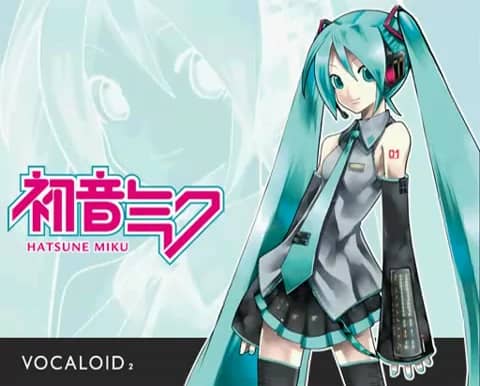Her Master’s Voice: The World of Virtual Idols, Part II
In Part I of this 3-part series, we looked at how the concept of the Virtual Idol first emerged in anime during the 1980s, featuring some of the more popular storylines and prominent idols to make an appearance in this genre, a phenomenon which could be seen as the precursor to an eventual reality where technology would let them enter our lives more directly. This is the reality that unfolds before us now!
As we enter the digital age, the possibilities open up considerably. Idols can go beyond just appearing in a futuristic context — and actually manifest as creations on our own computers!! The giant leap forward comes with the arrival of a line of software products called Vocaloids. Created by Crypton Future Media, and using technology developed by musical equipment giant Yamaha, a Vocaloid is a type of speech synthesis program which converts words and melodies designated by the user into an electronic singing voice.
There are some parameters for tweaking the sound, but for the most part each version of the program is based on one specific voice, and is tied to a related character avatar representing the singer. The first two major entries in the series featured a female singer named Meiko, along with her male counterpart Kaito. They remained somewhat obscure for most people though, at least in the beginning. It was the next entry, the first in the newer ‘Vocaloid2’ line, who was to become the star that would launch a massive cultural revolution in Japanese music — the virtual idol known as Hatsune Miku!!
Aside from sporting a more streamlined look and sound, Miku has more of a cute and chipper presence — and is more fully and unabashedly an idol — than her predecessor, the more mature and huskier-voiced Meiko; and, she seems a more complete melding of the quasi-human and technological, appearing to embrace her own artificial nature rather than trying to push past it, making her a bit more in step with the current times, you could say…!
Other Vocaloids have come along since Miku’s debut in 2007, and their profiles have no doubt benefitted from her popularity, as have those before her. But it continues to be Hatsune Miku herself who still grabs most of the media spotlight… with albums that have frequently placed in the Top Ten of Japan’s music charts, with even multiple #1 albums in fact, plus her own series of music based video games, and actual full-scale stadium concerts — including here in North America! — in which she performs onstage as a holographic projection, often with her own live band (and usually featuring appearances from other members of the Vocaloid entourage, naturally!)
She even had a performance on American television, as a musical guest on The Late Show with David Letterman!
Hatsune Miku – “Sharing The World” on The Late Show with David Letterman
Almost certainly, Japan is the only place in the world where such a thing could arise, and where a large portion of the general public could really wrap their heads around the idea, I’d say; however, a major part of what made it all possible was a gigantic fan community contributing their own Vocaloid-related content — which of course is largely the point, since Vocaloids are marketed as musical instruments.
The company decided early on to basically waive any and all rights to usage of their associated names and images for non-commercial purposes; although there is a massive grey area regarding what qualifies as pro versus fan level activity, which in itself is fairly unique to Japan. Many supposedly ‘amateur’ creations are easily on par with more official mass-market releases, with the main difference being in how they are sold/distributed to the public.
Mitchie M feat. Hatsune Miku – “Burenai Ai de”
Naturally, many creators easily transition from amateur to pro, once they have established themselves and their work to a certain degree… but in the beginning, almost the entirety of THIS massive-scale scene was at the more underground level.
A lot of the semi-professional and fan-created media in Japan springs from what is known as the ‘doujin’ scene, which is largely centered around indie manga comics but also extends to other forms of artwork, indie games, and music. Some are wholly original creations, and some reinterpretations of more established franchises; however, rather than being sold in stores, these products are circulated mainly at giant-scale fan conventions — the most well-known being the semi-annual Comiket (aka: Comic Market) event, which has hundreds of thousands of attendees.
Part of the reason why music has a significant profile here is that there is a large sub-category of producers who specialize in ‘Touhou’ releases, rearranging soundtrack selections from the popular Touhou series of indie computer games, which has led both directly and indirectly to a larger-scale adoption of Vocaloids and a further wave of music producers specifically devoted to them. The very anime-like nature of the Vocaloid characters also makes them an obvious fit within this scene, of course!
Likewise, many doujin/Touhou/Vocaloid producers also like to put visuals to their music, resulting in a proliferation of self-created music videos on sites like YouTube — although in Japan, the primary site for launching such things is Nico Nico Douga… and this is where much of the Vocaloid subculture has flourished, more than anywhere else out there. At one point in fact, it was estimated that thirty percent of ALL new videos on this site were Vocaloid videos!
Hachune Miku – “Ievan Polkka”
Hatsune Miku and her compatriots may be virtual idol performers, but that certainly doesn’t mean that they just do ‘idol music’… Contrary to popular belief perhaps, the term does not merely refer to the type of singers doing it, nor to just the type of cutesy-fied pop commonly associated with idols (even if it very often is that!). In the strictest and most modern sense, Japanese idol music is a musical genre with its own specific structures — most particularly, songs tend to be set up to encourage audience participation, sometimes with obvious short spaces for a call-and-response motif for instance, or optimized to allow the crowd to easily join in with shouty chanting and dance-like movements, making the concert more of a fun interactive communal experience…
Regardless of whether that template is used or not, the realm of idol music is one which can easily combine with a wide range of different musical styles — and it frequently DOES, most definitely! However, it seems that virtual idols are even more free to go in any possible direction with their music, to a far more extreme extent than most normal (non-virtual) idols; or at least, it happens far more often in Vocaloid territory. While you might have your fair share of cute and upbeat songs, plus some more gentle and introspective ones, it’s also not unusual to hear pounding techno music, heavy metal, or even some occasional skull-drilling experimental noise tracks featuring Hatsune Miku…!
She even has an entire compilation album of ‘shoegaze‘ music available, for fans of that particular style (which is titled “Mikgaze”, naturally). And as you might expect, she can also be found doing cover versions of existing songs quite often too — so, a very versatile performer, indeed!
Although it might seem like stating the obvious, virtual idols can only perform music they are given, and don’t really create their own songs…!! I mention it because that also tends to be the case with real-life idols; but in this case, (at least at this point in time!) the utter impossibility of it being otherwise underscores the inherent division between the producer and the performer, the user and the tool, the master and the servant, the real and the unreal — in a far more exaggerated form than in the real world, as it extends beyond just the actual performance, to literally dictating every single detail of their existence.
Much of this detail is brought to us through the mediums of artwork, stories, and music videos — and sometimes even within the lyrical content of the songs themselves, as some creators like to portray the characters (especially Miku) as being conscious of their role in the computerized reality they inhabit, adding a sort of ‘meta’ level to it all. [Given that enabling the vision of their owners/users to emerge is literally the entire reason for their existence though, Vocaloids seem to be quite enthusiastic about having the opportunity to fulfil their role!]
The end result is that it’s a whole multimedia subculture that is on offer now, not just a different category within the music scene… Part of the fun and charm of it all, and the thing which allows it to be scaled up to the level of a massive real-life concert event, is that people approach it with a willing suspension of disbelief, and knowingly play along with the make-believe scenario — whether it’s on the part of the audience, the creators, or even the virtual performers themselves! That’s a common thing perhaps in the realm of pure fiction, but here is a chance to take it a step further than that, one could say…
The quality of these indie-level Vocaloid productions can be surprisingly professional, to the point where it can be difficult to know whether they actually count as ‘official’ releases; however, when anything sees a such wide-scale adoption as Hatsune Miku, there will inevitably be some sub-par entries making the rounds as well, where our glorious diva with the turquoise-twintail hair just doesn’t quite sound as good as she ought to…?!
The fandom has an explanation for that too, though!! Sometimes you may even see it revealed in the video, but more often than not the truth is hidden… When you believe that you’re hearing Miku singing a song, it may in fact be one of two impersonators trying to creep into the limelight to ride her coat-tails (or perhaps in this case, twin-tails!) for a fleeting moment of pseudo-fame — you might actually be hearing from the boozy and somewhat washed-up singer known as Yowane Haku, easily identifiable if you actually see her since her silvery hair stands in stark contrast to Miku’s, even if she’s styled it the same; or, you might be hearing from an inexperienced and somewhat chaotic young idol named Akita Neru who – if you spot her – can be seen sporting a single anarchically angled blonde ponytail, instead. So, try not to be fooled by those two…!
Yowane Haku, Akita Neru – “Just Work! NEET”
On the other hand, there is a more official alter-ego of Miku who frequently makes an appearance sometimes too — a little pipsqueak version, whom anime fans would label as being a ‘chibi’ or ‘super-deformed’ version of her character, who is often seen waving around a leek (or green onion) in time with the music… but she is unequivocally still considered the ‘real Miku,’ although she’s sometimes given a slightly altered name (Hachune Miku) to reference this style of hers. [And for the Winter season, we might sometimes see another official Miku variant appear before us, as well… which would be the lovely Snow Miku!] The lore surrounding her has become nearly as mutifaceted as the music, it seems; but, newcomers to the scene will be relieved to hear that only Hatsune Miku has quite this level of diverse complexity, something which perhaps comes with being the breakout star of it all!
There is one other major category of Miku-related media which probably deserves a mention, in which Miku is tapped more for her idol dancing ability than her singing. Created with a program that is separate from the main Vocaloid software, these are called ‘MMD videos,’ an abbreviation for the very self-explanatory name of the program itself, Miku Miku Dance… The actual music to which she dances can be either Vocaloid or non-Vocaloid, as chosen by the user and then matched up with the visual options, resulting in exactly what you would expect — a video of Miku dancing to the song (what would be known as a ‘dance cover,’ in the real-life idol world).
[MMD] Snow Miku – “Star Night Snow”
It’s a natural extension really, particularly in Japan where many fans are already familiar with this idea and even have some pre-existing experience putting together such scenarios. It’s not unlike what happens in the popular iDOLM@STER series of video games (for the Xbox 360), in which players simulate developing and managing their own idol group, and stage auditions and performances for them. Arguably, the digitized singers featured in these games could also be considered virtual idols of a sort as well, even though the options for them are much more limited within the game’s parameters.
THE iDOLM@STER – “Go My Way”
iDOLM@STER videos are themselves plentiful on online video platforms, and there is a comparably gigantic media empire built up around these girls, with three or four iDOLM@STER character singles often appearing simultaneously on the Top Ten music chart (and sometimes even at number one, once again!) in Japan. And of course, there are still other similar and related things which continue to unfold over there, beyond just these…
We touch on a number of those in Part III.
John MacMaster lives in Halifax, Nova Scotia.


